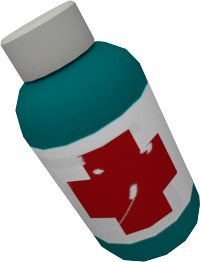item_healthkit_small
Jump to navigation
Jump to search
item_healthkit_small is a model entity available in ![]() Team Fortress 2.
Team Fortress 2.
Entity Description
Health kit entity - small size. Restores 20.5% health.
Keyvalues
- Name (targetname) <string>[ Edit ]
- The name that other entities refer to this entity by, via Inputs/Outputs or other keyvalues (e.g.
parentnameortarget).
Also displayed in Hammer's 2D views and Entity Report.See also: Generic Keyvalues, Inputs and Outputs available to all entities
- Pitch Yaw Roll (Y Z X) (angles) <QAngle>
- This entity's orientation in the world. Pitch is rotation around the Y axis, yaw is the rotation around the Z axis, roll is the rotation around the X axis.
TeamNum:
- Start Disabled (StartDisabled) <boolean>
- Stay dormant until activated (with the
Enableinput).
- Model ([todo internal name (i)]) <choices>
- Changes the in-game model to something other than the default model. Not shown in Hammer.
Value Description Default models/items/medkit_small.mdl Halloween Candy Bar models/props_halloween/halloween_medkit_small.mdl Birthday Cake small models/items/medkit_small_bday.mdl !FGD Dalokohs Bar on a plate models/workshop/weapons/c_models/c_chocolate/plate_chocolate.mdl !FGD Fishcake Bar on a plate models/workshop/weapons/c_models/c_fishcake/plate_fishcake.mdl !FGD Second Banana on a plate models/items/banana/plate_banana.mdl !FGD
- Auto-Materialize (AutoMaterialize) <boolean>
- Automatically respawns the health kit after it has been picked up (this is the standard behaviour). Additionally, disabling this option allows respawning the kit with the Enable input.
Inputs
EnableDisable:
- Enable / Disable
- Enable/disable this entity from performing its task. It might also disappear from view.
- Toggle
- Toggles the enabled/disabled status of the entity.
Outputs
- OnPlayerTouch
- Sent when the entity is picked up by a player.
